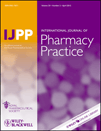Sustainability of a pharmacist-driven pathway for osteoporosis-related fractures on an orthopaedic unit after a 5-year period
Abstract
Objectives Diagnosis and management of osteoporosis in hospitals are poor. Effective medications for reducing fracture risk are often underutilised in hospital settings. Studies have shown that improvements in secondary prevention of osteoporosis can occur with the implementation of clinical pathways and are effective in improving the prescription for osteoporosis medications. We aimed to assess the long-term sustainability of the benefit of the osteoporosis pathway implemented at The Queen Elizabeth Hospital, Adelaide, Australia, in 2003.
Methods An audit was performed to review the rate of prescription for osteoporosis therapy 5 years after the implementation of a pharmacist-driven osteoporosis pathway in patients presented with a minimal trauma fracture and admitted to the Department of Orthopaedics at The Queen Elizabeth Hospital.
Key findings Our review of a 5-year period shows that the rate of prescription for osteoporosis therapy in this patient group is 95%.
Conclusions The pharmacist-driven osteoporosis pathway at The Queen Elizabeth Hospital has sustained the rate of prescription for osteoporosis therapy over a prolonged period of time.




